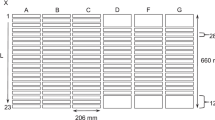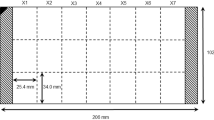Abstract
Background
The appearance of part distortion after machining is a recurring issue when manufacturing aerospace parts. Despite the development of distortion calculation and avoidance tools, this issue remains unsolved due to the difficulties in measuring accurately and economically the residual stresses of the machining blanks. In the last years, the on-machine layer removal method has shown its potential for automation and industrial implementation, offering the possibility to obtain the final component from blanks with measured residual stresses. However, the accuracy of this method remains unexplored.
Objective
Develop an uncertainty assessment procedure for the on-machine Layer Removal method in ribbed geometries and provide guidelines regarding data treatment.
Methods
A procedure to quantify the error associated with different uncertainty sources is presented and used. Once the main uncertainty source is determined, with Monte Carlo simulations the procedure is evaluated on aluminum alloy 7050-T7451 test-pieces under different data treatment alternatives.
Results
On-machine probing measurements are the main uncertainty source for the on-machine Layer Removal method for bulk residual-stress characterization. For the studied case, applying symmetry and data filtering reduces the uncertainty range which, is quantified for the different data treatment alternatives. Experimental results agree with simulations.
Conclusions
The present work demonstrates that the procedure to quantify uncertainty enables a rapid assessment of the bulk residual-stress measurement accuracy in relation to machining distortion.














Similar content being viewed by others
References
Bowden DM, Halley JE (2001) Aluminium reliability improvement program final report 60606. The Boeing Company, Chicago, IL, USA
Akhtar W, Lazoglu I, Liang SY (2022) Prediction and control of residual stress-based distortions in the machining of aerospace parts: A review. J Manuf Process 76:106–122. https://doi.org/10.1016/j.jmapro.2022.02.005
Prime MB, Hill MR (2002) Residual stress, stress relief, and inhomogeneity in aluminum plate. Scr Mater 46:77–82. https://doi.org/10.1016/S1359-6462(01)01201-5
Barcenas L, Ledesma-Orozco E, Van-der-Veen S et al (2020) An optimization of part distortion for a structural aircraft wing rib: an industrial workflow approach. CIRP J Manuf Sci Technol 28:15–23. https://doi.org/10.1016/j.cirpj.2020.01.007
Ma K, Goetz R, Srivatsa SK (2010) Modeling of Residual Stress and Machining Distortion in Aerospace Components. Defense Technical Information Center, Fort Belvoir, VA (Preprint)
Schajer GS (2013) Practical residual stress measurement methods. Wiley, Chichester, West Sussex, United Kingdom
Sun YL, Roy MJ, Vasileiou AN et al (2017) Evaluation of Errors Associated with Cutting-Induced Plasticity in Residual Stress Measurements Using the Contour Method. Exp Mech 57:719–734. https://doi.org/10.1007/s11340-017-0255-5
Robinson JS, Tanner DA, Truman CE, Wimpory RC (2011) Measurement and Prediction of Machining Induced Redistribution of Residual Stress in the Aluminium Alloy 7449. Exp Mech 51:981–993. https://doi.org/10.1007/s11340-010-9389-4
Pagliaro P, Prime MB, Swenson H, Zuccarello B (2010) Measuring Multiple Residual-Stress Components using the Contour Method and Multiple Cuts. Exp Mech 50:187–194. https://doi.org/10.1007/s11340-009-9280-3
Schajer GS (2010) Relaxation Methods for Measuring Residual Stresses: Techniques and Opportunities. Exp Mech 50:1117–1127. https://doi.org/10.1007/s11340-010-9386-7
Prime MB (1999) Residual Stress Measurement by Successive Extension of a Slot: The Crack Compliance Method. Appl Mech Rev 52:75. https://doi.org/10.1115/1.3098926
Dreier S, Denkena B (2014) Determination of Residual Stresses in Plate Material by Layer Removal with Machine-integrated Measurement. Procedia CIRP 24:103–107. https://doi.org/10.1016/j.procir.2014.07.137
Aurrekoetxea M, López de Lacalle LN, Llanos I (2020) Machining Stresses and Initial Geometry on Bulk Residual Stresses Characterization by On-Machine Layer Removal. Materials 13:1445. https://doi.org/10.3390/ma13061445
Aurrekoetxea M, Llanos I, Zelaieta O, Lopez de Lacalle LN (2021) Improving accuracy of bulk residual stress characterization in ribbed geometries through equivalent bending stiffness. Procedia CIRP 102:325–330. https://doi.org/10.1016/j.procir.2021.09.056
Hill MR, Olson MD (2014) Repeatability of the Contour Method for Residual Stress Measurement. Exp Mech 54:1269–1277. https://doi.org/10.1007/s11340-014-9867-1
Prime MB, Sebring RJ, Edwards JM et al (2004) Laser surface-contouring and spline data-smoothing for residual stress measurement. Exp Mech 44:176–184. https://doi.org/10.1007/BF02428177
Liu L, Sun J, Chen W, Sun P (2015) Study on the machining distortion of aluminum alloy parts induced by forging residual stresses. Proc Inst Mech Eng Part B J Eng Manuf 231:618–627. https://doi.org/10.1177/0954405415583805
Wang Z, Sun J, Liu L et al (2019) An analytical model to predict the machining deformation of frame parts caused by residual stress. J Mater Process Technol 274:116282. https://doi.org/10.1016/j.jmatprotec.2019.116282
Timoshenko JNG (1940) Theory of plates and shells. McGraw-Hill Book Company, Incorporated, New York and London
Llanos I, Aurrekoetxea M, Agirre A et al (2019) On-machine Characterization of Bulk Residual Stresses on Machining Blanks. Procedia CIRP 82:406–410. https://doi.org/10.1016/j.procir.2019.04.012
Gulpak M, Sölter J, Brinksmeier E (2013) Prediction of Shape Deviations in Face Milling of Steel. Procedia CIRP 8:15–20. https://doi.org/10.1016/j.procir.2013.06.058
ASTM (2008) Standard Test Method for Determining Residual Stresses by the Hole-Drilling Strain-Gage Method, Standard Test Method E837–08. American Society for Testing and Materials, West Conshohocken, PA
Grant PV, Lord JD, Whitehead PS (2002) The Measurement of Residual Stresses by the Incremental Hole Drilling Technique. National Physical Laboratory, UK
Chantzis D, Van-der-Veen S, Zettler J, Sim WM (2013) An Industrial Workflow to Minimise Part Distortion for Machining of Large Monolithic Components in Aerospace Industry. Procedia CIRP 8:281–286. https://doi.org/10.1016/j.procir.2013.06.103
Rahman MdM, Mayer JRR (2016) Measurement accuracy investigation of touch trigger probe with five-axis machine tools. Arch Mech Eng 63:495–510
Renishaw RMP600 high accuracy radio machine probe. Renishaw. (© 2001-2022 Renishaw plc. All rights reserved). https://www.renishaw.com/en/rmp600-high-accuracy-machine-probe--8880. Accessed 31 Aug 2022
Funding
This work has been done under the framework of the project: "MIRAGED: Posicionamiento estratégico en modelos virtuales y gemelos digitales para una industria 4.0 (CER-20191001),” supported by Centro para el Desarrollo Tecnológico Industrial (CDTI)–Acreditación y concesión de ayudas destinadas a centros tecnológicos de excelencia “CERVERA".
Author information
Authors and Affiliations
Corresponding author
Ethics declarations
Ethical Approval
This article does not contain any studies with human participants or animals performed by any of the authors.
Conflict of Interest
None of the authors has a conflict of interest in connection with the reported investigation.
Additional information
Publisher's Note
Springer Nature remains neutral with regard to jurisdictional claims in published maps and institutional affiliations.
Rights and permissions
Springer Nature or its licensor (e.g. a society or other partner) holds exclusive rights to this article under a publishing agreement with the author(s) or other rightsholder(s); author self-archiving of the accepted manuscript version of this article is solely governed by the terms of such publishing agreement and applicable law.
About this article
Cite this article
Aurrekoetxea, M., López de Lacalle, L.N., Zelaieta, O. et al. Uncertainty Assessment for Bulk Residual Stress Characterization Using Layer Removal Method. Exp Mech 63, 323–335 (2023). https://doi.org/10.1007/s11340-022-00918-7
Received:
Accepted:
Published:
Issue Date:
DOI: https://doi.org/10.1007/s11340-022-00918-7




